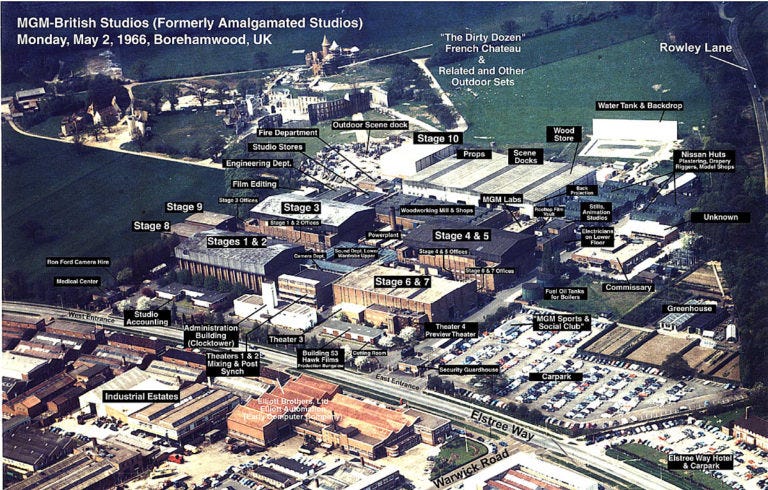The Borehamwood Village -
It’s October 1966. The initial Portmeirion shoot has wrapped and The Prisoner crew moves to MGM-British studios in Borehamwood. The remainder of the year is taken up with shooting the studio material for the first six episodes - the four I’ve already covered, plus ‘The Chimes Of Big Ben’ and ‘Degree Absolute’ (which will be renamed ‘Once Upon A Time’). The second of these is actually the first half of the finale of the whole thing, despite there being another ten episodes left to shoot to fill the CBS order.
Some background to keep in mind about the last quarter of 1966.
The big news stories in the UK are the Aberfan tragedy, the escape of super spy George Blake from HMP Wormwood Scrubs, and a lot of very fraught negotiations between the Labour government and Rhodesia.
Cultural news. William Hartnell becomes Patrick Troughton.
The Who are recording ‘A Quick One’ and the Stones are recording ‘Between The Buttons’ - and the Beatles are having a little break until December, their first proper one. Lennon is filming How I Won The War in Europe. Big hits of the period include ‘Good Vibrations’ and ‘The Green, Green Grass Of Home’.
We welcome to the planet David Cameron, Jeremy Hunt, and Gordon Ramsay (whoopee), and say goodbye to Walt Disney.
And The Prisoner unveils its stunning interior sets to the crew; P’s cottage living quarters. The all-seeing control room. The hospital wards and examination room. The endlessly adaptable, redressable chamber with a revolving rostrum beneath that serves as Number 2’s Living Space - but also as the Labour Exchange inner office, the ballroom at the Town Hall, the interior of the Exhibition Hall.
And then there are the studio sets that will stand in as exteriors for sections of the Village. Because another lengthy first unit shoot in Portmeirion is financially and logistically unthinkable. And there are another thirteen episodes to make.
MGM-British
This studio (never to be confused with Elstree, which was just up the road, and where most of The Prisoner’s ITC stablemates were shot) was the bees’ knees, widely regarded as the best film studio in Europe. McGoohan was clearly very fond of it, using it for most of Danger Man. Logistics force the last handful of episodes to Shepperton, but he doubles back asap to MGM for The Prisoner.
The complex was built in 1936 as Amalgamated Studios, but for complicated financial reasons (and the small matter of a world war), it didn’t actually produce a film until 1949, five years after being bought up and renamed by MGM. (J. Arthur Rank bought it in 1938 purely to stop any of his rivals getting it, which was taking dog-in-the-manger to astonishing levels.) There’s a wonderful history in more detail here.
Famous films made at MGM-British include Murder At The Gallop, Village Of The Damned, 633 Squadron, Quatermass And The Pit, The Dirty Dozen, Where Eagles Dare and Goodbye Mr Chips. The studio closed in 1970, right in the middle of the shoot for Gerry Anderson’s TV series UFO.
But it will always be chiefly remembered as the home of the production of 2001: A Space Odyssey, which eventually made use of all ten of the stages. Its shoot ran there from late 1965 to early 1968. So Stanley Kubrick and co were filming right next to McGoohan and co throughout the production of The Prisoner.
(There is a wonderful story about the continuity girls on the two productions meeting over a cup of tea in the canteen during the shooting of ‘Fall Out’. ‘What did it all turn out to be about then, your one?’ asks the 2001 girl. ‘Something to do with monkeys,’ replies the Prisoner girl. ‘Oh, mine too,’ sighs the 2001 girl.)
Interior Exteriors
Before I crack into ‘Chimes’ as an episode in itself, I want to take a look at the studio sets that stand in for Portmeirion.
Keep reading with a 7-day free trial
Subscribe to The Culture Bunker to keep reading this post and get 7 days of free access to the full post archives.




